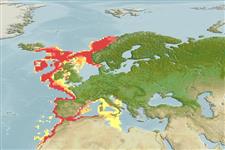Teleostei (teleosts) >
Gadiformes (Cods) >
Gadidae (Cods and haddocks)
Etymology: Gadiculus: Latin, gadus = a fish, cod? (Ref. 45335).
More on author: Guichenot.
Environment: milieu / climate zone / depth range / distribution range
Ecology
Marine; pelagic-oceanic; non-migratory; depth range 100 - 1000 m (Ref. 35388). Temperate; 69°N - 24°N, 18°W - 17°E
Northeast Atlantic: found in the western Mediterranean and in the Atlantic around the Strait of Gibraltar and to the south along the Moroccan coast.
Size / Weight / Age
Maturity: Lm ? range ? - ? cm
Max length : 16.1 cm TL male/unsexed; (Ref. 128593); common length : 10.0 cm TL male/unsexed; (Ref. 1371); max. published weight: 48.98 g (Ref. 128593); max. reported age: 3.00 years (Ref. 1371)
Dorsal
spines
(total): 0;
Anal
spines: 0. Eyes large; mouth oblique; chin barbel absent. Color varies from pink to light brown dorsally, silvery on sides and ventrally (Ref. 1371). Scales large, silvery and easily detached. Lateral line ends in 7 open mucus grooves on the upper side of the head (Ref. 35388).
Occurs in large schools over mud, muddy sand, gravel and rock bottoms. Feeds on small crustaceans and maybe worms. Preyed upon by other valuable fish (Ref. 1371). Spawns in the winter in the western Mediterranean and in the spring farther north (Ref. 35388).
Life cycle and mating behavior
Maturity | Reproduction | Spawning | Eggs | Fecundity | Larvae
The major spawning grounds are located in the western part of the Mediterranean, on both sides of the Straits of Gibraltar, in deep water.
Cohen, D.M., T. Inada, T. Iwamoto and N. Scialabba, 1990. FAO species catalogue. Vol. 10. Gadiform fishes of the world (Order Gadiformes). An annotated and illustrated catalogue of cods, hakes, grenadiers and other gadiform fishes known to date. FAO Fish. Synop. 125(10). Rome: FAO. 442 p. (Ref. 1371)
IUCN Red List Status (Ref. 130435)
Threat to humans
Harmless
Human uses
Fisheries: minor commercial; bait: usually
More information
ReferencesAquacultureAquaculture profileStrainsGeneticsElectrophoresesHeritabilityDiseasesProcessingNutrientsMass conversion
Tools
Warning: mysqli::__construct(): (HY000/1040): Too many connections in /var/www/html/includes/speciessummary.lib.php on line 2414
Can't connect to MySQL database fbquizv2. Errorcode: Too many connections
